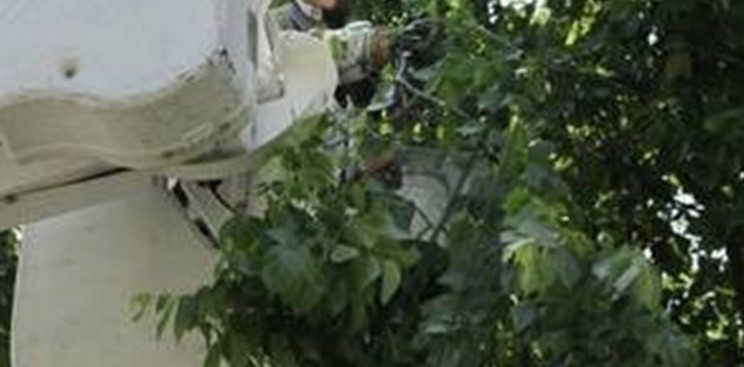Dallas-Area Trees Took a Beating in Powerful Storms


Published May 10, 2014 By JEFF MOSIER and CHRISTINA ROSALES
Commuters were still dodging downed trees that blocked streets Friday morning, while workers cleared debris after powerful storms whipped through the area the previous day.
The National Weather Service said the damage was probably caused by straight-line winds rather than a tornado. But a survey team couldn’t rule out a twister.
“There are still things I need to see, like video footage,” said Mark Fox, a Weather Service meteorologist. “But right now, the evidence is consistent with straight-line winds up to 80 mph.”
In northwest Dallas, a 19-year-old Henderson County woman was killed Thursday morning when the driver she was riding with lost control on a rain-slick street, police said. The car struck a curb and then crashed into a tree. The victim’s name hadn’t been released.
The torrential rain also led to a high-water rescue of five boys who were playing hooky in Oak Cliff.
Dallas officials were still trying to determine whether the city sustained enough damage to qualify for federal assistance.
Much of Thursday’s storm damage seemed to involve falling trees, one of which slowed service on a DART light-rail line.
The storms flipped over a semi-trailer on Interstate 30 and pulled bricks from the front of New Beginning Covenant Ministries in West Dallas.
Areas that appeared to be the hardest-hit were around downtown, central Dallas, the Park Cities and north and northeast Dallas.
Steve Houser, owner of Arborilogical Services Inc. in Wylie, said his company received about 40 calls for service in the 24 hours after the storms. He said he was surprised that 80 percent of those were about whole trees falling on houses, cars, power lines and streets.
Houser said the damage was severe but not as bad as that caused by the ice storm in early December, after which he received hundreds of calls daily about downed trees and branches.
“It appears that the trees that were weak structurally were the ones that were going over first,” he said, pointing to fungal root infections as a likely contributing factor.
Dr. Dotty Woodson, a water resource specialist with Texas A&M University AgriLife Extension Service, said winds pounded the trees as heavy rains saturated the ground that anchored their roots.
“When the ground is very, very saturated, I’ve seen whole gigantic trees, and their roots come right out of the ground,” Woodson said.
Woodson said poor maintenance is also a significant factor in storm damage. Some trees haven’t been properly trimmed and have too much weight on one side or too much up top. Others might have had weakened root systems caused by too little — or too much — watering.
“It’s not just the drought that can affect it, but overwatering can have an effect,” she said. “They don’t have as good of a root system as they would have in a natural area that got plenty of rainfall.”
Selecting trees that that don’t thrive in the local clay soil also contributes to problems.
Dallas Morning News gardening columnist and landscape architect Howard Garrett said ornamental trees such as crape myrtles and redbuds are poor choices for areas near sidewalks and roads.
“The best trees for the parkway are the tall shade trees that, at maturity, will arch high over the street, creating a wonderful environment, he said. “Some of the best choices include live oak, red oak, Texas ash, cedar elm, Mexican white oak, bigtooth maple and Mexican sycamore.”
Even rain soaking into the bark adds to troubles.
“It’s not just the wind,” Woodson said. “It’s also the weight of the water, just like the weight of ice during ice storms.”
Houser, who expects his call volume to double this weekend, said the stress of urban life also weakens trees around here. He said underground utilities, acres of pavement and poor air quality are all problems.
“Trees’ roots underneath all that concrete don’t do well,” he said. “The average tree in downtown [Dallas] lives about 15 to 18 years.”
Just south of Mockingbird Lane on Winton Street, a tree that neighbors said was 100 years old had toppled over a Volkswagen Golf. The tree’s branches were massed 6 feet high and sprawled out on the lawn.
Large trees around homes on Westway Avenue in Highland Park seemed to be the most damaged, with some fallen onto roofs of large homes.
By lunchtime Friday, landscaping crews in the area were just about finished gathering the mangled tree branches and loading them into trucks.
On Aransas Street in West Dallas, Estela Sanchez said none of her trees was damaged. But high winds had sent other branches through the living room window of the house where she has lived for 10 years.
“It seemed like it came out of nowhere,” she said.
Billy White, president of the Westmoreland Park Neighborhood Association, said tree damage was widespread in that area.
“Everyone is saddened by what has happened, but they have insurance, which is key, and everyone is safe,” White said.
Staff writers Christina Rosales and Marianna Greene contributed to this report.
Tips for Keeping Your Trees Healthy
- Water for multiple short periods, with breaks of an hour or two in between.
- Hire a professional to periodically check root system health.
- Plant trees that are accustomed to the local soil. Try the Texas A&M University Agrilife Extension Service interactive guide: texastreeplanting.tamu.edu.
- Trim trees to make sure the weight of the branches is evenly distributed and the tree canopy isn’t top-heavy.
SOURCES: Dr. Dotty Woodson, Texas A&M University AgriLife Extension Service; Philip Erwin, chief arborist for the city of Dallas
